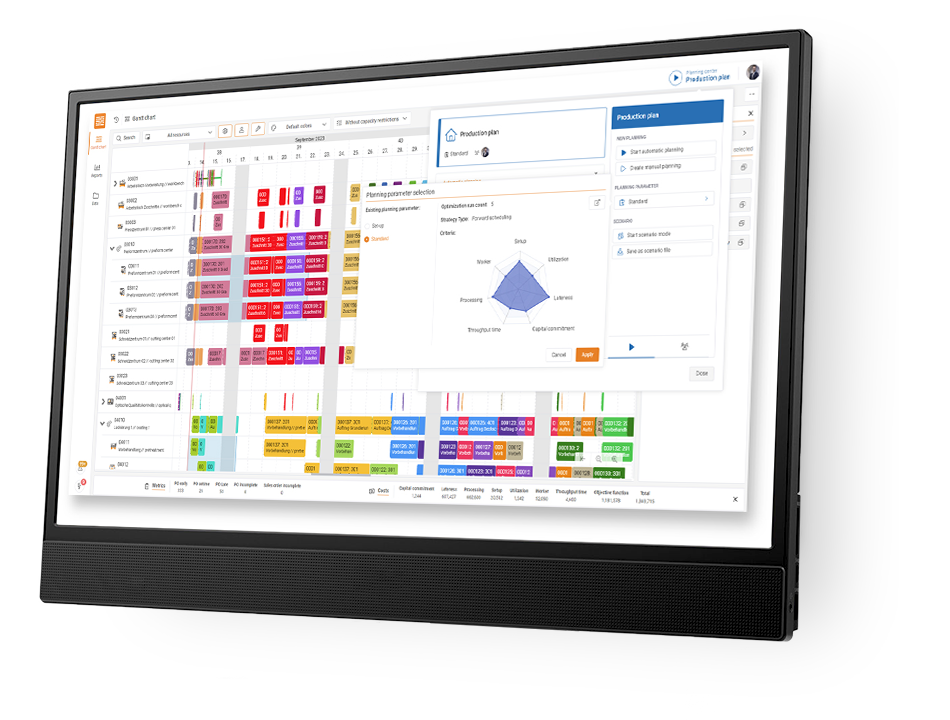Keypoints
-
- Enhances Production Efficiency: PCCs improve production planning and control by providing real-time resource monitoring, detailed scheduling, and transparent visualisation of current production states, ensuring efficient and accurate planning.
-
- Integration with ERP Systems: Seamlessly integrates with ERP systems to optimise production processes, facilitate automated planning, and ensure optimal resource utilisation with real-time data.
-
- Flexibility and Adaptability: Allows planners to quickly adapt to changing conditions, such as emergency orders or machine maintenance, with features like interactive planning and quick impact assessment of schedule changes.
-
- Future-Ready and Scalable: PCCs support the shift towards automated planning, functioning as essential monitoring and analysis tools, and providing scalability and intelligent algorithms for dynamic production environments.
What is Production Control Centre (PPC)?
A Production Control Centre is an essential tool that complements a Production Planning and Control (PPC) system in manufacturing. It enhances production management by enabling detailed planning and monitoring of available resources, making production processes more flexible, efficient, and effective.
The Role of a Production Control Centre
A PCC is crucial for overseeing all networked machines in a production environment. It provides planners with a comprehensive view of their manufacturing processes, ensuring sufficient resources are available and facilitating detailed scheduling. When used alongside a PPC system, it offers a clear and extensive representation of the current production status, enhancing communication and planning transparency.
“The Conductor of the Factory Symphony”

Imagine a factory as a grand orchestra. Each machine, worker, and resource plays its unique instrument. The PCC is the conductor, standing at the podium, with a comprehensive view of the entire ensemble. It ensures that every note (task) is played in harmony, synchronising the musicians (resources) to produce a flawless performance (efficient production).
Just as the conductor adjusts the tempo and guides the musicians through complex passages, the PCC adapts to changes, manages schedules, and optimises processes in real-time. It transforms potential chaos into a symphony of productivity, ensuring that the factory operates seamlessly and efficiently.
Benefits of Using a Production Control Centre
A PCC aligns capacity supply with demand, allowing for precise production planning and tracking. Key benefits include:
-
- Improved adherence to schedules
-
- Shortened lead times
-
- Better utilisation of storage capacity
-
- Increased transparency
-
- Accurate planning
Integration with the ANT PPC System
The PCC is highly valued in manufacturing, particularly when integrated with the ANT PPC system. This combination optimises all production processes through automated planning and execution, eliminating long lead times and schedule delays. The ANT system ensures optimal resource and machine utilisation with real-time control, structured data, and clear information on current orders.
Requirements for a Production Control Centre
For effective planning and production, a PCC must receive real-time information, ideally from integrated ERP systems with PPC capabilities. The seamless integration of ANT’s planning and control system into the any ERP software ensures efficient and accurate data transmission.
Successful companies complete manufacturing orders efficiently and on time, necessitating cost-optimised detailed planning of all resources, including personnel, machinery, tools, materials, and other aids. A scalable PCC is crucial for maintaining transparency and flexibility in scheduling. It should allow planners to customise views, such as displaying all orders within a specific period (year, month, week, day, or hour), enabling optimal resource planning and detailed scheduling.

More benefits with ANT Solutions’s APS
High Transparency
In the realm of cost-optimised production planning and control, handling large data volumes is essential. However, transparency in the current state of production is often lacking, complicating detailed planning. The PCC addresses this by displaying available resources and their actual usage, providing all necessary information at a glance. This transparency allows planners to make accurate statements regarding completion and delivery dates.
The ANT PPC visualises the entire plant’s workload on planning-relevant resources. A simple traffic light system indicates which orders are started (green), critical (yellow), or delayed (red). Shift models, interruption times, order networks, and critical paths are clearly displayed, with the option for planners to define user-specific views or configure their own colour schemes.
High Flexibility
Production processes do not always run linearly in practice. Emergency orders from key customers, unexpected staff absences, or early machine maintenance can disrupt schedules. To adapt to these constantly changing conditions, planners must be able to reschedule at any time. ANT APS allows for interactive planning, enabling planners to quickly and flexibly adjust schedules and immediately see the impacts on other orders. Resource availability and lead times can be analysed with a click, ensuring swift adjustments to production plans.
Optimisation of Production
Intense competition, cost pressures, and changing customer requirements force companies to optimise their production further. Optimising resource allocation depends on various parameters, which often conflict with each other. The ANT PCC provides all relevant information, enabling automatic order scheduling based on weighted objectives like setup times, personnel costs, production costs, lead times, capacity utilisation, capital binding, and on-time delivery. This results in a balanced production plan, even if all objectives cannot be optimised simultaneously.
The Future of Production Control Centres
As production planning systems become more intelligent, the role of the PCC evolves. While some planners still use the PCC for manual planning, it increasingly functions as a monitoring and analysis tool in automated planning environments. The trend towards automated planning does not eliminate the planner’s role but shifts it towards oversight and control, supported by smart tools and assistance systems.
Essential Features of a Production Control Centre
A PCC should meet the following requirements:
-
- Provision of real-time information
-
- Cost-optimised detailed planning
-
- Scalability
-
- Intelligent algorithms
These features are necessary to adapt quickly to changing customer demands and market conditions, ensuring all planning tasks are promptly adjusted.
The PCC remains a vital component in production planning and control. Even as systems become more automated, the need for transparency, flexibility, and intelligent planning tools ensures the PCC’s continued relevance. Combining automated and manual planning processes offers the best results, allowing planners to maintain control while benefiting from advanced technological support.
More about planning

Production Optimisation, How to Effectively Use Modern Production Software?
What is production optimisation? Production optimisation is the process of identifying and implementing improvements to production processes in order to increase efficiency, reduce costs, and

Production planning in APS as a method for reacting rapidly to process dynamics
The APS system is an advanced tool for planning production and responding to events occurring in real time. Integration of the software with other management

Advanced Planning and Scheduling (APS)
AdvancedPlanning & Scheduling (APS) Planning and scheduling production is made more accessible with ANT’s APS software. Maintain a constant production pace with the help of

